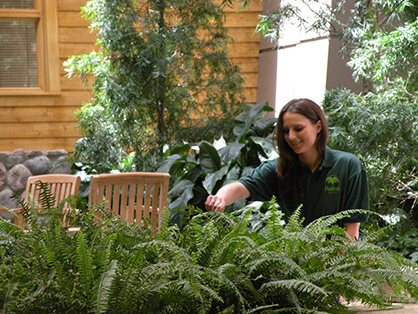For More Information please download: Indoor Healing Garden White Paper
 How healing gardens benefit hospitals
How healing gardens benefit hospitals
Adding an indoor healing garden to enhance health and recovery may not be a new idea. But as our technology advances, indoor landscapes are poised to become even more critical to health and wellbeing.
Healing gardens provide us with easy access to live plants and nature. Interior plantscapes have been shown to aid in the process of recovery. At Planterra we understand the many benefits that indoor gardens can provide for those in hospitals and medical facilities.
Healing Gardens are therapeutic by nature
Adding natural elements like live plants or living walls can reduce stress levels in patients. Incorporating aspects of nature into an unfamiliar environment, like an indoor garden at a hospital, can be relaxing to patients and their families – as well as employees.
In 2001, a 200-person study titled Evaluating a Children’s Hospital Garden Environment: Utilization and Consumer Satisfaction proved these theories. The study noted that 90 percent of adults reported a positive change in mood after spending time in a garden environment. And children with autism were reported as having more visual interest in the natural setting; it provided a positive distraction during treatment.
Indoor plants transform a hospital stay
For those considering the addition of indoor landscaping in a healthcare environment, it’s important to recognize how adding live plants can benefit any healthcare setting:
- Plants promote healing - Live plants can offer a place of peace and refuge, one shown to elevate a patient’s mood.
- Plants decrease stress - The addition of a healing garden or living wall will create a calming environment, one where guests, employees and patients alike can benefit from lower blood pressure and stress levels.
- Plants have even been shown to increase productivity for those at work in the hospital, too.
- Plants improve your overall sensory experience - Adding water features may mask hospital sound. Lush greenery can provide privacy, comfort, and even aid in directing visitors through the hospital.
 Therapeutic indoor gardens come in any size
Therapeutic indoor gardens come in any size
Therapeutic and healing gardens are designed to suit the needs in an available space. A garden may be restricted to a small corner or designed to fill a large, lush atrium. In either case, the vibrant growing plantscape will produce a beneficial addition.
Interior plantscapes are affordable. Plans to add indoor plants can be developed to suit any budget. They promise high-impact benefits without an excessive cost.
As the interior landscape provider for many of the nation’s leading medical institutions, our experts at Planterra understand concerns that may be unique to hospital professionals and those managing medical facilities. We work directly with the hospital and healthcare staff and understand their goals and the needs of those working within the confines of a building’s master plan.
The cost of adding a healing garden may be considered a sustainable option for adding value to a healthcare setting. Therapeutic interior landscaping offers a welcoming space to gather. It is also one suited to fundraising efforts.
Hospital management may choose to commemorate donors with a tribute imprinted on a bench, stone, plaque or planter. These items can be carefully worked into a healing garden’s design.
Allergy-free indoor plants
When installing healing gardens within a hospital setting, experts at Planterra use informed practices to ensure the plants chosen for any design are a safe, healthy addition to the environment.
We’ll match plants that are a custom fit for your needs and the space available. We offer allergy-free plant options that do not release airborne pollen. Allergy-free planting involves choosing the right blooming plants, like a bromeliad, or monitoring non-blooming plants closely to ensure they grow safely without flowering. If a bud begins to develop, our experts are ready. It would be removed by a skilled horticultural technician.
Interior landscapes often include topdressing to protect the plants. Natural Spanish Moss is a common choice - and a known allergen. It is a standard practice to replace any such allergens with a safer, artificial variety of moss or topdressing.
Safe, sterile plant maintenance
We make every consideration when planning an indoor healing garden. We use soil-less growing media in the live plants. Soil-less growing media allows plants to thrive in a sterilized, soil-less mixture, free of organic materials which could attract pests or mold.
When it comes to watering, Planterra uses a self-contained technology called sub-irrigation. This system of water-wicking technology ensures that a precise amount of water will be supplied as the plants need it.
When live plants are not an option, Planterra can install realistic replica plants to enhance the space. Replica foliage adds beauty and interest to space. It also comes with a cleaning and dusting option to help maintain the sterility and safety of a medical environment.
When it comes to maintaining plants and creating a healing environment, Planterra staff upholds the highest standards of cleanliness, safety, and privacy. We believe a healthcare setting can also be a peaceful and calming place to recover.
It’s easy to feel good about contributing to the addition of a healing garden space because they are directly linked to health benefits. Put simply, plants are good for us. Find out more about adding a healing garden by contacting our designers at Planterra.
Planning a project? Contact us.
Project Contact
For information on events visit the Planterra Conservatory website
